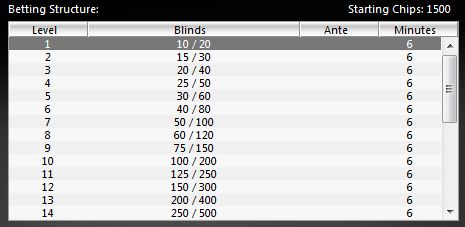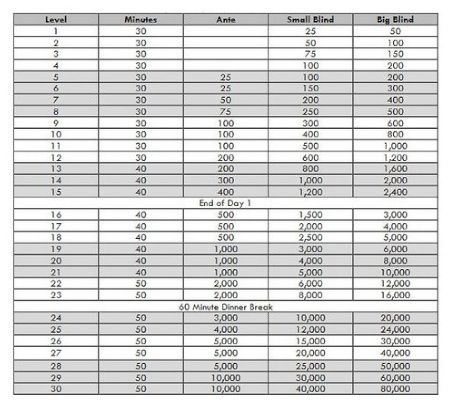Poker Tournament Structure
The blind structure (or schedule) is one of the most important details of running a successful tournament. Gradual increases of the blinds at each level and finishing on time are characteristics of a good blind structure.
Online Poker Tournaments Payout Structure explains how the Tournament will payout. Based on the number of players, the tournament pays out. A schedule of Bellagio poker tournaments, including time, buy-in, blind structure, and more. You also can find Bellagio phone number, address, and website info.
To calculate a blind structure, the minimum information you need is the number of players, target duration, and the starting blind level (which is usually the smallest chip denomination you have). It is also necessary to know how many chips there will be in play and how many rounds there will be. The blind calculator tool below can take care of that and help set up your perfect structure.
A shootout tournament is slightly different in structure as the players are not shuffled around to balance tables as players are knocked out. Each table plays until there is one winner per table. All the winners then play against each other until there is one overall winner. The blind structure calculator lets you create the perfect blind structure for your tournament in just a few clicks Concentrate on your cards Stop running back and forth to the computer, connect as many devices as you want to the tournament and manage everything from the poker.
To calculate a blind structure, you need the starting blind level, the estimated total value of the tournament chips in play (initial buy-ins plus rebuys and add-ons) and the desired length of the tournament. Use the tool below to help set up your perfect structure.
Please enter the smallest chip denomination
Poker Tournament Structure Template
Please enter a tournament length
Please enter the number of players
This section discusses some tournament blind structure theory, which explains why the PokerSoup.com tournament blind structure calculator suggests blind levels the way it does and what you can change to create the right blind structure for your game.

Starting Number of Blinds

Most tournaments start with 50-100 big blinds. Anything around 200 big blinds is considered a 'deep stack' tournament. Deep stack tournaments are considered to be full of skillful poker play and not just pushing your money all in before the flop. The latter occurs quickly in tournaments that start with less than 50 big blinds, which are also aptly nick-named 'luck-fests'. There just aren't enough chips to maneuver and play real poker.
If all other variables are held constant, starting a tournament with larger chip stacks will increase the length of the game.
Rebuys and Add-ons
The number of rebuys and add-ons in a tournament also effect the total number of chips in play during a tournament. If no other changes are made, more rebuys and add-ons make for a longer tournament.
Poker Tournament Structure
Blind Level Round Length
Most live tournaments employ blind level lengths of 15, 20, 30, 45, or 60 minutes. The blind calculator can calculate blinds for any of these blind levels. With a set tournament length, longer blind levels result in less number of rounds and shorter blind levels result in more rounds.
Gradual Blind Increase

The greatest benefit of using the PokerSoup.com tournament blind structure calculator is the assurance of constantly increasing blind amounts. This is an important aspect of tournament play. If the blinds increase (preferably slowly) at a constant rate, players do not spend an inordinate amount of time being deep- or short-stacked and there are no game-altering blind increases in the middle of the tournament.

For example, if the blinds increase from 150/300 to 200/400, that is an increase of 33%, or (200+400)/(150+300). This is a comfortable increase. Similarly, in the later stages of the tournament after many players are knocked out, a blind increase from 3000/6000 to 4000/8000 is also 33%.

End Goal
Eventually, the blinds (and antes) induce action to end the tournament. After all, a tournament usually does have a set duration (or a goal, anyway). As a player, it is up to you to figure out how aggressive it is necessary to play in order to keep up with the blinds. Constant gradual increases make this easier to figure out.